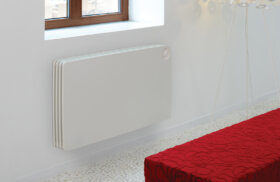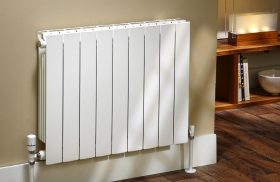With winter fully upon us and the current cost of living crisis, unfortunately, affecting us all, any small adjustments we can make to keep warm will help us to feel more comfortable. So, does the colour of your radiator affect the heat output?
Which colour and finish is best?
In terms of heat conduction, black is always the most successful. This is due to the way it takes on the light. Black absorbs all light wavelengths before converting them into other forms of energy, most commonly heat, where it then emits the heat into its environment. The opposite can be said for white as white absorbs no light, therefore converting the light into heat.
Matte or gloss finish? A more shiny, reflective surface is less likely to conduct heat, meaning that a gloss finish provides a lower heat output in comparison to a matt finish. Therefore it can be concluded that a matte black radiator would be the most efficient of the colour choices. This being said the difference in heat emissions between this choice and other colours is a very low percentage.
To visit one of our radiator showrooms.
St Albans | Brighton | Islington | Clapham | Leamington Spa | Bristol
Painting your radiator
Remembering that a shiny surfaced radiator doesn’t conduct heat as efficiently, we can agree that chrome or polished steel models wouldn’t be the number one choice.
One of these model types can provide 15% less heat than if that same model were painted. If this is the type you already have and are concerned about this fact or simply want to add a pop of colour to your room, painting your radiator could be an option to consider.
When painting your radiator, the type of paint you opt for is paramount to the longevity of the finish, as well as the radiator’s efficiency. You could go for a metallic paint which is a popular choice.
The paint contains small flakes of metal, which you would think would aid in heat emission; however it leaves a shine to the surface and will therefore not be as heat-efficient. With oxide and other metal compounds used in the pigment of non-metallic paints, a layer of this type would work as long as it were specifically made for radiators. Due to the constant change in temperatures, standard paints aren’t as effective and will start to crack over time.
So in conclusion, buying a coloured radiator won’t actually make a massive difference to heat output. So if you’re looking for a splash of colour on your new designer radiator, go for it!
The majority of our radiators have a wide choice of RAL colours and finishes so you’re bound to find the one that’s perfect for your home.





